2016 was a big year for Colorado TU, the last 11 months have seen challenges present themselves from protecting our headwaters from acid mine drainage, to making sure our public lands remain in public hands, to ensuring the state's quality of water and natural habitat. While these challenges threatened our rivers and streams, the work by TU and it's chapters, made sure these threats remained just that and our watersheds remained protected. CTU also embarked on programs that would help sustain conservation and fishing for years to come. We engaged the next generation of river stewards through our Youth Camp, introduced a new group of kids to conversation through fly fishing, reintroduced native greenback cutthroat trout to their home watersheds along the front range, and made on-the-ground improvements to our state's fisheries through our chapter's volunteer efforts.
There were many great success stories over the last year that will be covered in the 2016 Year in Review coming out early 2017. The few stories listed below are highlights of the last year for CTU and just a glimpse into the great work done by the TU staff, our chapters, volunteers, and partners! Stay tuned for the 2016 Year in Review for more articles covering all of the great work done in Colorado!
Roan Plateau
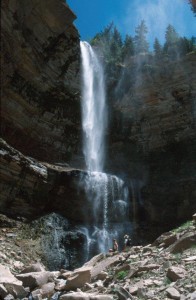
Throughout the past decade, Colorado TU has also been involved in advocacy and litigation to help protect the Roan in the face of proposed oil and gas development. The legal battle culminated in productive settlement talks that produced the new Roan plan that BLM approved in November. For the next 20 years, the most sensitive watersheds atop the Roan will remain unleased, while responsible development will be allowed on other areas on and around the Plateau that are closer to existing oil and gas infrastructure. Continued improvements in directional drilling technology over those years could make it possible, by the time BLM next updates the Roan plan, to extend development to natural gas reserves below the Roan without needing to sacrifice the valuable habitat on its surface. This agreement is a great example of how balance can be achieved when all parties sit down and try to listen honestly and respectfully to each other to craft a solution.
Thompson Divide

Concurrent with the Roan decision, The BLM also issued a decision canceling 25 contentious oil and gas leases within the Thompson Divide (the leaseholders to be repaid from government funds), while maintaining 40 other leases in surrounding lands – mostly closer to existing development areas. As with the Roan, the decision reflects a responsible balance between protecting our most valuable fish and wildlife habitats and enabling responsible energy development to move forward on public lands. Unlike the Roan, this decision does not yet reflect a larger consensus among conservationists and industry, nor does it provide longer-term protection for the Thompson Divide. The decision was a necessary victory in protecting the Thompson Divide from the imminent threat of oil and gas drilling, and TU remains committed to working with the BLM, Forest Service, ranchers, local governments, and the oil and gas industry to achieve a long-term solution that includes permanent protection of the Thompson Divide as part of a larger, responsible plan for energy development in the region.
Stream Standards
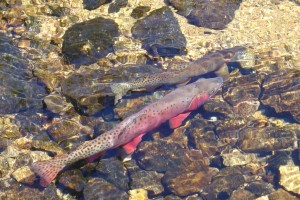
Trout Unlimited and a coalition of agencies, concerned citizens, and conservation and sportsmen groups rallied to defend Colorado’s water quality standards for temperature in coldwater streams. The Colorado Water Quality Control Division (WQCD) proposed changes in standards that would have raised standards for water temperature to levels that could prove fatal to trout in spring and fall seasons and year-round in mid-elevation “transition” waters. The proposal was based on flawed science and failed to adequately protect coldwater fisheries and to address the varied factors that influence temperature regimes in natural streams. Thanks to the efforts of TU and our coalition partners, the Water Quality Control Commission (WQCC) rejected the proposed changes, keeping in place the protective temperature standards that currently apply to coldwater streams. It was an impressive team – including Colorado Parks and Wildlife, the Colorado Wildlife Federation, the Environmental Protection Agency (EPA), Western Resource Advocates, and others. The proposed changes would have weakened water temperature standards for around 1/3 of Colorado’s trout streams, based solely on their elevation, allowing the fish’ stress levels to increase and ultimately cause problems for feeding, growth and movement. According to the EPA, the proposed standards for lower elevation coldwater streams could have actually proved lethal to trout exposed to them over seven days.
Greenback Recovery
 Colorado TU teamed up with Colorado Parks and Wildlife to reintroduce Greenback Cutthroat trout into their native watersheds all along the Front Range. Efforts this past year including spawning Zimmerman Lake, receiving grants to help improve the Mt. Shavano fish hatchery that raises Greenbacks, and expanded Greenback efforts to educating the public on why all native trout reintroduction is vital to our ecosystems. CTU has also worked with Parks and Wildlife on preliminary plans for a fish barrier on Rock Creek that will eventually hold Greenbacks. CTU volunteers worked with CPW on the beginning stages of the project by stocking fish in a section of the stream.
Colorado TU teamed up with Colorado Parks and Wildlife to reintroduce Greenback Cutthroat trout into their native watersheds all along the Front Range. Efforts this past year including spawning Zimmerman Lake, receiving grants to help improve the Mt. Shavano fish hatchery that raises Greenbacks, and expanded Greenback efforts to educating the public on why all native trout reintroduction is vital to our ecosystems. CTU has also worked with Parks and Wildlife on preliminary plans for a fish barrier on Rock Creek that will eventually hold Greenbacks. CTU volunteers worked with CPW on the beginning stages of the project by stocking fish in a section of the stream.






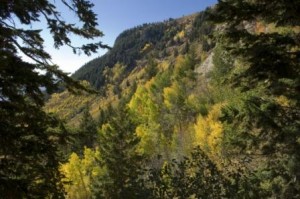
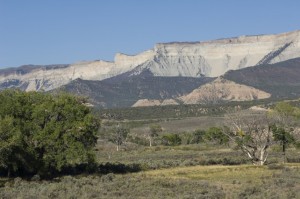 The MLP process is a new tool that promises to address some of that top-down, fragmented approach to public land management. To their credit, the BLM is listening and incorporating suggestions from local ranchers, conservation groups and elected officials into their leasing plan for South Park.
The MLP process is a new tool that promises to address some of that top-down, fragmented approach to public land management. To their credit, the BLM is listening and incorporating suggestions from local ranchers, conservation groups and elected officials into their leasing plan for South Park. The Roan Plateau is home to outstanding big game habitat and unique native trout like those pictured here. Trout Unlimited has been hard at work on the Roan for more than two decades, with many hundreds of volunteer hours invested by the Grand Valley Anglers chapter on habitat protection and improvement projects from instream structures to riparian fencing and replanting. TU also helped install a fish barrier to protect native cutthroat trout habitat being restored by Colorado Parks and Wildlife.
The Roan Plateau is home to outstanding big game habitat and unique native trout like those pictured here. Trout Unlimited has been hard at work on the Roan for more than two decades, with many hundreds of volunteer hours invested by the Grand Valley Anglers chapter on habitat protection and improvement projects from instream structures to riparian fencing and replanting. TU also helped install a fish barrier to protect native cutthroat trout habitat being restored by Colorado Parks and Wildlife. The Thompson Divide (including Thompson Creek pictured here) makes up more than 220,000 acres of federal land in Pitkin, Garfield, Gunnison and Mesa counties and contains some of Colorado's most productive habitat for big game, cutthroat trout and numerous other native species. The area is used by more than 10,000 resident and nonresident big game hunters every year and serves as the headwaters to some of Colorado’s most popular fisheries including the Roaring Fork, North Fork of the Gunnison, and Crystal River.
The Thompson Divide (including Thompson Creek pictured here) makes up more than 220,000 acres of federal land in Pitkin, Garfield, Gunnison and Mesa counties and contains some of Colorado's most productive habitat for big game, cutthroat trout and numerous other native species. The area is used by more than 10,000 resident and nonresident big game hunters every year and serves as the headwaters to some of Colorado’s most popular fisheries including the Roaring Fork, North Fork of the Gunnison, and Crystal River.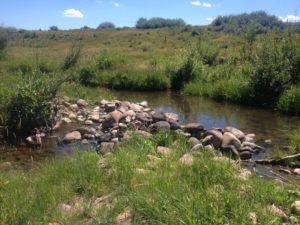 A small creek in southwest Wyoming just got a big upgrade. This November, a push-up style diversion was improved to a fish-friendly rock vane structure with a head-gate, reconnecting approximately 6 miles of habitat for the native Colorado River cutthroat trout that reside there. This project was unique in that it all began with the local school. Trout Unlimited partnered with the McKinnon Elementary School to study their home water, the Henry’s Fork River, through the Adopt-a-Trout program. This particular program involved tagging Colorado River cutthroat trout with telemetry tags and tracking their movement from 2014-2016. The students each got to “adopt” their own fish and follow it throughout the year. They learned a variety of river ecology lessons, including fish anatomy, macroinvertebrate identification, applying the scientific method, riparian ecosystems and many more. They also had to map where their fish moved using Google Earth.
A small creek in southwest Wyoming just got a big upgrade. This November, a push-up style diversion was improved to a fish-friendly rock vane structure with a head-gate, reconnecting approximately 6 miles of habitat for the native Colorado River cutthroat trout that reside there. This project was unique in that it all began with the local school. Trout Unlimited partnered with the McKinnon Elementary School to study their home water, the Henry’s Fork River, through the Adopt-a-Trout program. This particular program involved tagging Colorado River cutthroat trout with telemetry tags and tracking their movement from 2014-2016. The students each got to “adopt” their own fish and follow it throughout the year. They learned a variety of river ecology lessons, including fish anatomy, macroinvertebrate identification, applying the scientific method, riparian ecosystems and many more. They also had to map where their fish moved using Google Earth.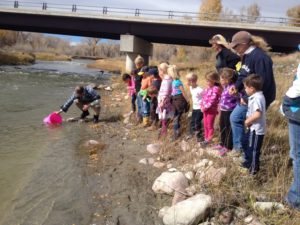 Using two years of the Adopt-a-Trout data and an instream flow study that TU conducted on Beaver Creek, a major tributary, we discovered that there was a push-up dam near the confluence to the Henry’s Fork that was not allowing fish passage for a critical part of the year. None of the students’ fish were able to pass that point during the summer months. So, TU collaborated with the Lonetree Ranch to develop a fish-friendly diversion that would still allow them to receive their irrigation water, but would allow for fish passage during low flows. A head-gate was also installed so that they could turn the ditch off when they no longer needed to irrigate, leaving more water instream for the trout. Thanks to the funding provided by the Wyoming Landscape Conservation Initiative, the Wyoming Wildlife Natural Resource Trust and the Natural Resources Conservation Service, the project was able to be completed November 2016.
Using two years of the Adopt-a-Trout data and an instream flow study that TU conducted on Beaver Creek, a major tributary, we discovered that there was a push-up dam near the confluence to the Henry’s Fork that was not allowing fish passage for a critical part of the year. None of the students’ fish were able to pass that point during the summer months. So, TU collaborated with the Lonetree Ranch to develop a fish-friendly diversion that would still allow them to receive their irrigation water, but would allow for fish passage during low flows. A head-gate was also installed so that they could turn the ditch off when they no longer needed to irrigate, leaving more water instream for the trout. Thanks to the funding provided by the Wyoming Landscape Conservation Initiative, the Wyoming Wildlife Natural Resource Trust and the Natural Resources Conservation Service, the project was able to be completed November 2016.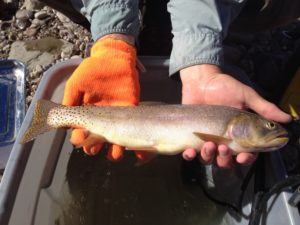 This is just the first of many projects that will be done along Beaver Creek to benefit native trout. Over the next year, the McKinnon students will be assisting with vegetation planting and monitoring on several sections right above the diversion to provide better cover and reduce stream temperatures during the summer months. Projects like these are not only reconnecting populations of native trout, but reconnecting kids to “their” fish and river.
This is just the first of many projects that will be done along Beaver Creek to benefit native trout. Over the next year, the McKinnon students will be assisting with vegetation planting and monitoring on several sections right above the diversion to provide better cover and reduce stream temperatures during the summer months. Projects like these are not only reconnecting populations of native trout, but reconnecting kids to “their” fish and river.
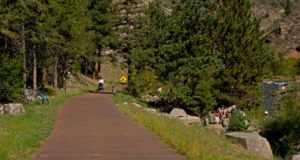 The trail includes not only 3 miles of a paved multiuse trail, but features 3 bridges, 6 new formal river access points and multiple overlooks and boulder seating areas. Other improvements include two new parking lots and an expanded parking lot and restroom at Mayhem Gulch. The parking lots are a key component to bringing a new types of visitor to Clear Creek Canyon; cyclists, hikers and walkers.
The trail includes not only 3 miles of a paved multiuse trail, but features 3 bridges, 6 new formal river access points and multiple overlooks and boulder seating areas. Other improvements include two new parking lots and an expanded parking lot and restroom at Mayhem Gulch. The parking lots are a key component to bringing a new types of visitor to Clear Creek Canyon; cyclists, hikers and walkers.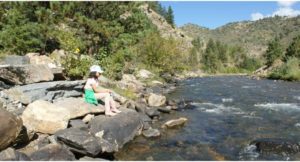 t was encouraging to see extended families walking the trail, leaning over the guardrail at an overlook pointing to trout rising behind a large boulder. Joggers pushing strollers paused at the overlooks on the bridges to catch their breath. Cyclists were numerous and one group took advantage of the informal boulder seating areas to stop for a picnic lunch. There were crowds of climbers at all of the popular areas, and fisherman were ducking in and out of the willows along the banks.
t was encouraging to see extended families walking the trail, leaning over the guardrail at an overlook pointing to trout rising behind a large boulder. Joggers pushing strollers paused at the overlooks on the bridges to catch their breath. Cyclists were numerous and one group took advantage of the informal boulder seating areas to stop for a picnic lunch. There were crowds of climbers at all of the popular areas, and fisherman were ducking in and out of the willows along the banks.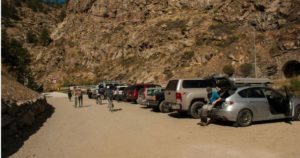 My overall impression of the trail was extremely positive. The materials used through compliment the character of the Canyon. The improved parking areas provide additional spaces and greatly improve visitor safety and the new signage is clear and concise. The biggest improvement; however, is the trail. It allows visitors to disconnect from Highway 6 and truly immerse themselves in the Creek, the Canyon, and the Landscape.
My overall impression of the trail was extremely positive. The materials used through compliment the character of the Canyon. The improved parking areas provide additional spaces and greatly improve visitor safety and the new signage is clear and concise. The biggest improvement; however, is the trail. It allows visitors to disconnect from Highway 6 and truly immerse themselves in the Creek, the Canyon, and the Landscape.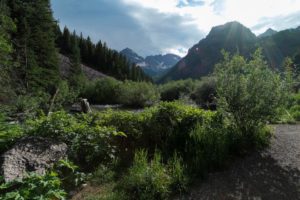 We have always prided ourselves on our ability to work in a bipartisan manner. Since Trout Unlimited was founded in Michigan in 1959, the organization has existed—and grown—through 11 different presidential administrations (29 years Republican, and 28 years Democrat). For example, several clear opportunities exist for us in the new Congress and with the new Trump Administration; these include Good Samaritan legislation to help clean up abandoned mines, a higher priority on water infrastructure improvements, and public land renewable energy legislation.
We have always prided ourselves on our ability to work in a bipartisan manner. Since Trout Unlimited was founded in Michigan in 1959, the organization has existed—and grown—through 11 different presidential administrations (29 years Republican, and 28 years Democrat). For example, several clear opportunities exist for us in the new Congress and with the new Trump Administration; these include Good Samaritan legislation to help clean up abandoned mines, a higher priority on water infrastructure improvements, and public land renewable energy legislation.
 At the
At the 
